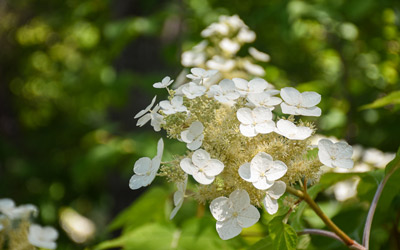June Blooms
Every season brings its own sort of magic to the Garden experience, but there’s no doubt summer is a special time of year. As summer commences, keep an eye out for some of these June favorites.

Bee balm (Monarda spp.)
New England is home to four native beebalm species. Also called wild bergamot, beebalm is part of the mint family. Blooms can appear in white, pink, red, lavender, and purple and resemble tiny firework explosions. A pollinator favorite, the narrow, tubular flowers of beebalm attract hummingbirds, bees, and butterflies among others.
Location(s): Garden of Inspiration, Wildlife Refuge Pond, meadows, and naturalistic spaces

False indigo (Baptisia spp. and cultivars)
Blooming in mid to late May, false indigo features tall spikes of pea-like flowers with blooms that come in shades of blue, white, yellow, pink, and purple. These upright perennials resemble lupine, and the plants grow along woodland edges, thickets, and streambanks from Pennsylvania south to North Carolina and Tennessee.
Location(s): Secret Garden and The Ramble

Peony (Paeonia spp. and cultivars)
These popular flowers are a perennial classic. Blooming in late May and continuing throughout early summer, peonies come in various colors including red, pink, white, and yellow. The Garden has a collection of tree, intersectional, and herbaceous peonies. Most are incredibly fragrant, but fragrance can vary depending on the plant.
Location(s): Along the Perennial Path/Beneficial Border, in the Lawn, Secret, and Cottage Gardens, and Garden of Inspiration

Mountain laurel (Kalmia latifolia cultivars)
This iconic, multi-stemmed, broadleaf evergreen shrub is native to eastern North America where it can be found in woodlands and along rocky outcrops. Easily recognized, mountain laurel has round clusters of blossoms that range in color from white to pink, and even some shades of red. The plant is the state flower of both Connecticut and Pennsylvania.
Location(s): All over the Garden, from the Lawn and Shade Gardens to The Ramble, Inner Park, and naturalistic spaces

Foxglove (Digitalis purpurea)
A biennial, this plant produces only green leaves in its first year, then produces beautiful flowers in the second year. Foxgloves are late spring bloomers that attract hummingbirds. The flowers are tubular, funnel-shaped, and pink to purple in color, often have purple and white spots inside and are closely grouped along the spike they grow on.
Location(s): Cottage Garden, Garden of Inspiration, and Beneficial Border

False goat’s beard or false spirea (Astilbe spp. and cultivars)
Astilbe is a genus of nearly 20 species. The herbaceous perennials are native to eastern Asia and eastern North America. Most notably, the plant’s tiny flowers are densely packed onto fern-like mounds. The colors include purple, red, pink, and white. There are an assortment of species and cultivars found throughout the Garden, with some native species located within the Beneficial Border.
Location(s): Secret, Cottage, and Lawn Gardens, Garden of Inspiration, and Beneficial Border

Oakleaf hydrangea (Hydrangea quercifolia and cultivars)
An upright, multi-stemmed, deciduous shrub, oakleaf hydrangea typically grows four to six feet tall. Native to North America, the shrub can be found within woodlands and along bluffs and ravines from Georgia to Florida and Louisiana. One of the most notable characteristics of the plant is its white flowers that are produced in the summer. Come fall, the leaves of the shrub will transition from green to dark red, offering beautiful views.
Location(s): Along Pliny’s Allée, Entry Garden, and between The Court and Cottage Garden

Winterberry (Ilex ‘Sparkleberry’)
There are over 400 species within the Ilex genus. This hybrid winterberry usually matures to be six to ten feet tall and often just as wide. A cross between I. serrata and I. verticillata, it is noted for its dense, heavy fruiting of vibrant red berries. The shrub is slow-growing and will have greenish-white flowers in late spring.
Location(s): Beneficial Border

Sea holly (Eryngium planum)
This perennial has blooms of a steely violet-blue color, often on flower heads that resemble thistles. The plant is easily grown in dry, well-draining soil and will slowly spread over time. At the Garden, this plant can often be found intermixed with an assortment of other perennials of contrasting colors and characteristics in the Secret Garden.
Location(s): Secret and Lawn Gardens

Mountain mint (Pycannthemum muticum)
An aromatic perennial, mountain mint can grow one to three feet tall. The plant is native to eastern North America where it can be found in grassy open places, meadows, fields, and in low woodland areas. Mountain mint has a strong mint-like fragrance when its dense leaves are crushed. The flowers of the plant are attractive to both butterflies and bees.
Location(s): The Court, Lawn Garden, Wildlife Refuge Pond, and The Ramble
